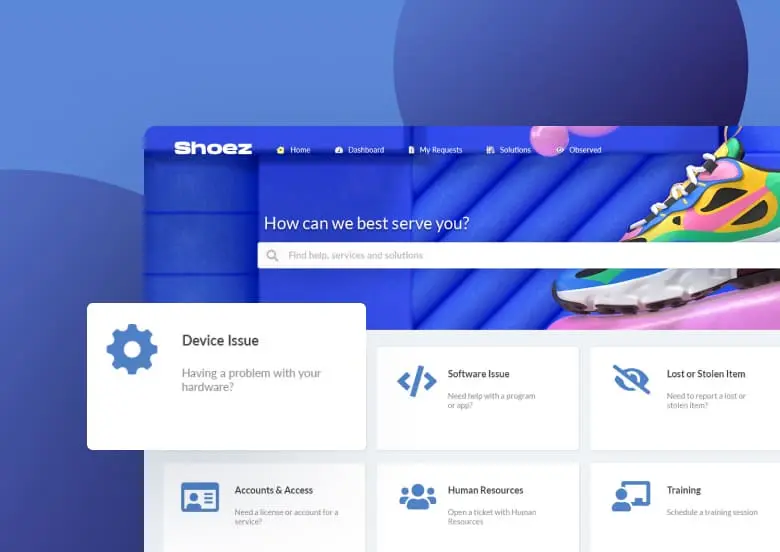Digital transformation is no longer just a buzzword; it's a necessity for businesses aiming to thrive in a rapidly evolving landscape. By integrating digital technologies into all areas of an organization, companies can fundamentally change how they operate and deliver value to customers.
This transformation is not merely about technology; it’s about rethinking how businesses engage with customers, streamline operations and processes, and create value in an increasingly digital world.
In this article, we will explore the ins and outs of digital transformation, including its definition, benefits, challenges, and best practices for successful implementation. We’ll also discuss the critical role of IT Service Management (ITSM) in this journey.
So, get ready to embark on a journey towards a more digital future!
What exactly is digital transformation?
In the first place, digital transformation refers to the process of integrating digital technology into all aspects of an organization, leading to fundamental changes in how the business operates and delivers value to customers.
This concept has evolved significantly over the years, moving from simple digitization of processes to transforming traditional and non-digital business processes, creating new ones, and continuously evolving all aspects of business models, operations, and interactions with customers.

14 Steps for a Solid Digital Transformation Strategy in 2024
Historical context of digital transformation
The term "digital transformation" gained traction in the early 2000s as businesses began to recognize the potential of digital technologies. Initially, it focused on automating existing processes.
However, as technology advanced, the definition expanded to include a holistic approach that involves rethinking business models, customer engagement strategies, and operational efficiencies.
Key components of digital transformation
There are several components of digital transformation. We listed the most common:
-
Technology integration: Implementing new digital technologies to enhance processes and improve efficiency. In the recent years, the integration of Artificial Intelligence (AI) and Machine Learning(ML) played a crucial role in this, enabling businesses to leverage data and digital analytics and technologies for significant improvements.
-
Cultural change: Fostering an environment that embraces digital innovation, collaboration, and agility.
-
Customer-centricity: Focusing on delivering exceptional customer experiences through personalized services and interactions.
-
Data-driven decision making: Utilizing data analytics to inform business strategies and improve operational performance.
Benefits of digital transformation
The advantages of digital transformation are manifold and can significantly impact an organization’s performance and competitiveness. These are the main benefits of digital transformation:
1. Enhanced operational efficiency
Digital transformation streamlines processes, reduces manual tasks, and automates workflows, leading to increased productivity. For instance, companies can utilize robotic process automation (RPA) to handle repetitive tasks, freeing up employees to focus on more strategic initiatives.
2. Improved customer experience
In today’s digital age, customers expect seamless, personalized experiences. Digital transformation allows businesses to leverage data and analytics to understand customer preferences and behaviors better. This insight enables companies to tailor their offerings, resulting in higher customer satisfaction and loyalty.
3. Increased agility and innovation
Organizations that embrace digital transformation can respond more quickly to market changes and customer demands. This agility fosters a culture of innovation, where businesses can experiment with new ideas and technologies without fear of failure. For example, companies like Netflix and Amazon have successfully transformed their operations, leading to significant market advantages and customer loyalty.
4. Competitive advantage
In a crowded marketplace, digital transformation can set a company apart from its competitors. By adopting advanced technologies and innovative practices, businesses can create unique value propositions that attract and retain customers.
Challenges in digital transformation
Despite its benefits, digital transformation comes with challenges that organizations must navigate carefully. Digital transformation strategies are crucial to ensure good outcomes. These are the main challenges we could identify:
1. Resistance to change
One of the most significant hurdles is resistance to change. Employees may be hesitant to adopt new technologies or processes, fearing that they will disrupt their routines or threaten their job security. To overcome this, organizations must foster a culture that embraces change and innovation.
2. Technology integration issues
Merging new technologies with legacy systems can be complex and costly. Organizations may face challenges in ensuring compatibility and functionality across different platforms. A well-thought-out integration strategy is crucial to mitigate these issues.
2. Skills gap
The rapid pace of technological advancement often outstrips the skills of the current workforce. Organizations may struggle to find employees with the necessary expertise to implement and manage new technologies. Investing in training and development is essential to bridge this skills gap.
3. Managing costs and expectations
Digital transformation can require significant financial investment, and organizations must carefully manage their budgets and expectations. Setting realistic goals and timelines is critical to ensuring that the transformation process is sustainable and effective.
Steps to implement a digital transformation strategy
Implementing a successful digital transformation strategy involves several key steps:
1. Assess current capabilities
Understanding where your organization stands in terms of technology, processes, and culture is the first step. Conduct a thorough assessment to identify strengths, weaknesses, and areas for improvement.
2. Define clear goals
Establish what you want to achieve with your digital transformation. Clear, measurable goals will guide your efforts and help you track progress.
3. Engage stakeholders
Involve all relevant parties, including employees, management, and customers, to ensure buy-in and support. Effective communication is key to fostering a collaborative environment.
4. Choose the right technology
Select tools and technologies that align with your goals and integrate well with existing systems. Consider scalability and flexibility to accommodate future growth. Stay up to date with emerging technologies. That can give you an edge over your competitors.

ITSM Tools Comparison: Top 16 Service Desk Software Alternatives
5. Implement changes incrementally
Avoid overwhelming your organization by making gradual changes. Start with pilot projects as part of a digital transformation strategy to test new technologies and processes before rolling them out on a larger scale.
6. Measure success
All digital transformation initiatives must be measured. Use key performance indicators (KPIs) to evaluate the effectiveness of your transformation efforts. Regularly review and adjust your strategy based on data-driven insights.
Empowering business leaders in the transformation journey
This in not a step of a digital transformation process, but it's good to talk about it right from the start. Business leaders play a critical role in driving digital transformation initiatives. Their vision, commitment, and ability to inspire others are essential for fostering a culture of innovation and change.
Leaders should prioritize communication and collaboration, ensuring that all stakeholders understand the goals and benefits of digital transformation. Additionally, investing in leadership development and training can equip leaders with the skills needed to navigate the complexities of digital transformation.
Human Centered Leadership
Discover the power of embracing the human element in IT and leadership
Download for free
Best practices for successful digital transformation
Implementing effective digital transformation strategies is crucial for careful planning and adaptation. To enhance the chances of success, consider these best practices:
1. Foster a culture of innovation
Encourage experimentation and new ideas among employees. Create an environment where failure is seen as a learning opportunity rather than a setback.
2. Prioritize customer needs
Always keep the customer experience at the forefront of your transformation efforts. Solicit feedback and use it to inform your strategies.
3. Leverage data analytics
Utilize data to drive decisions and improve processes. Data analytics can provide valuable insights into customer behavior, operational efficiency, and market trends.
4. Ensure ongoing training
Provide continuous learning opportunities for employees to keep pace with new technologies. Investing in training will empower your workforce and enhance their skills.
The role of digital tools in digital transformations
Digital tools are the backbone of any successful digital transformation. These tools can range from cloud computing and data analytics to AI software and Machine Learning. By leveraging these technologies, organizations can automate processes, gain insights from data, and enhance customer interactions.
For example, customer relationship management (CRM) systems can help businesses better understand customer preferences and behaviors, leading to more personalized experiences. Similarly, AI-driven analytics can provide actionable insights that drive strategic decision-making.
4 examples of successful digital transformation
Digital transformation is not just a theoretical concept; it has been successfully implemented by numerous organizations across various industries. These companies have leveraged digital technologies to enhance their operations, improve customer experiences, and gain business value and a competitive edge in the market.
By examining these real-world examples, we can gain valuable insights into the strategies and approaches that lead to successful digital transformation. Here are a few notable cases:
Adobe
Adobe, the software company behind products like Photoshop and Acrobat, underwent a major transformation in the late 2000s. They shifted from a license-based model to a subscription-based, cloud-hosted service called Creative Cloud.
This transition allowed Adobe to offer more frequent updates, better integration across products, and more flexibility for customers. Adobe also made strategic acquisitions, such as web analytics company Omniture and e-commerce platform Magento, to expand its capabilities. The company invested heavily in its workforce, focusing on employee happiness, benefits, and employer branding to attract and retain top talent.
Lego
Lego, the iconic toy company, transformed its enterprise IT system to improve data sharing across the organization. By implementing a new ERP system, Lego was able to better manage its supply chain, manufacturing, and distribution processes. This digital transformation enabled Lego to respond more quickly to market demands and deliver products to customers more efficiently.
Walmart
Walmart, the world's largest retailer, has made significant strides in its digital transformation efforts. The company has invested heavily in e-commerce, AI, IoT, machine learning, and cloud technologies to enhance its operations and customer experience. Walmart's digital transformation has allowed it to compete more effectively with online retailers like Amazon.
Spotify
Spotify, the music streaming service, has embraced an agile culture and mindset to drive its digital transformation. The company uses cross-functional teams, trust, and autonomy to foster innovation and efficiency. Spotify's digital transformation has enabled it to continuously experiment, learn, and stay ahead of the competition in the rapidly evolving music streaming industry.
These examples demonstrate how digital transformation can unlock new opportunities for growth, innovation, and customer engagement across various industries. By embracing digital technologies and fostering a culture of agility and experimentation, organizations can position themselves for long-term success in the digital age.
Role of IT Service Management (ITSM) in digital transformation
IT Service Management plays a crucial role in facilitating digital transformation. ITSM tools help organizations manage their IT services effectively, ensuring that new technologies are integrated smoothly and that users receive the support they need.
So, to sum up, by managing IT services efficiently, ITSM supports digital transformations, driving improvements in products, processes, strategies, workforce, and customer engagement. These changes have a huge impact in business models.

5 Ways to Tackle Digital Transformation With ITSM
What is ITSM?
In a nutshell, IT Service Management refers to the activities and processes that organizations use to design, deliver, manage, and improve IT services. It encompasses a range of practices, including incident management, problem management, change management, and service desk operations.
IT Service Management offers benefits on multiple levels. It can help individuals to discharge their responsibilities more efficiently and effectively. It can help IT service providers to deliver better IT services and support to employees and external customers. And it can help businesses to better use technology as both an enabler and competitive differentiator and provide better products and services to customers.
In terms of the individuals and teams, ITSM provides defined responsibilities and better ways of working that are enabled by technology. These are “ITSM tools” – software solutions that digitally enable the key ITSM processes.
How ITSM tools facilitate digital transformation
Service desk software provide a framework for managing IT services and support. They enable organizations to:
-
Streamline processes: Automate routine tasks and improve efficiency.
-
Enhance communication: Facilitate collaboration between IT and business units.
-
Improve user experience: Offer self-service options and quick resolution of issues.
-
Provide insights: Use analytics to monitor performance and identify areas for improvement.
Overview of InvGate Service Management

InvGate Service Management is a powerful ITSM solution that helps organizations manage their IT services effectively. Its user-friendly interface and robust features make it an ideal choice for businesses undergoing digital transformation. Key features include:
-
Automated workflows: Streamline processes and reduce manual tasks.
-
Self-service portal: Empower users to resolve issues independently.
-
Analytics and reporting: Gain insights into service performance and user satisfaction.
-
Integration capabilities: Seamlessly connect with other tools and systems.
By leveraging InvGate Service Management, organizations can enhance their IT Service Management and support their digital transformation efforts.
Conclusion
Digital transformation is a journey that requires commitment, strategy, and the right tools. By understanding its benefits, challenges, and best practices, organizations can navigate this complex landscape successfully.
Staying informed about digital transformation trends is crucial for remaining competitive in today's market. Additionally, examining examples of digital transformation can provide valuable insights into real-world applications and strategies.
Embrace digital transformation and unlock new opportunities for growth and innovation in your business. For more resources and support, explore what InvGate has to offer!
Frequenlty Asked Questions (FAQs)
What is digital transformation?
Digital transformation refers to the process of integrating digital technology into all aspects of a business, leading to fundamental changes in how the business operates and delivers value to customers.
What is the first step in digital transformation?
The first step is to assess your current capabilities and identify areas for improvement.
How does digital transformation impact employee roles?
It often leads to new roles and responsibilities, requiring employees to adapt and learn new skills.
Can small businesses benefit from digital transformation?
Absolutely! Small businesses can leverage digital tools to enhance efficiency and compete effectively.
What technologies are essential for digital transformation?
Key technologies include cloud computing, data analytics, AI, and automation tools.
How can InvGate Service Management support my digital transformation journey?
InvGate Service Management provides an intuitive platform for managing IT services, facilitating smooth transitions, and enhancing user experiences.
This expanded version of the article provides a comprehensive overview of digital transformation, its benefits, challenges, and practical steps for implementation, while also emphasizing the role of ITSM and InvGate Service Management. It is designed to engage readers and provide valuable insights into the topic.

















